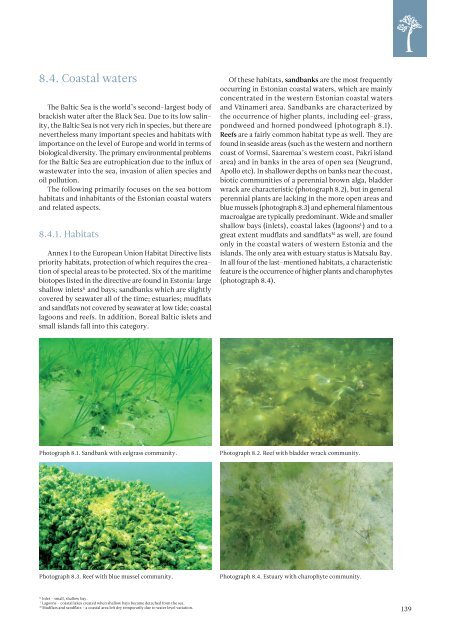ESTONIAN ENVIRONMENTAL REVIEW 2009
ESTONIAN ENVIRONMENTAL REVIEW 2009
ESTONIAN ENVIRONMENTAL REVIEW 2009
Create successful ePaper yourself
Turn your PDF publications into a flip-book with our unique Google optimized e-Paper software.
8.4. Coastal waters<br />
The Baltic Sea is the world’s second-largest body of<br />
brackish water after the Black Sea. Due to its low salinity,<br />
the Baltic Sea is not very rich in species, but there are<br />
nevertheless many important species and habitats with<br />
importance on the level of Europe and world in terms of<br />
biological diversity. The primary environmental problems<br />
for the Baltic Sea are eutrophication due to the influx of<br />
wastewater into the sea, invasion of alien species and<br />
oil pollution.<br />
The following primarily focuses on the sea bottom<br />
habitats and inhabitants of the Estonian coastal waters<br />
and related aspects.<br />
8.4.1. Habitats<br />
Annex I to the European Union Habitat Directive lists<br />
priority habitats, protection of which requires the creation<br />
of special areas to be protected. Six of the maritime<br />
biotopes listed in the directive are found in Estonia: large<br />
shallow inlets K and bays; sandbanks which are slightly<br />
covered by seawater all of the time; estuaries; mudflats<br />
and sandflats not covered by seawater at low tide; coastal<br />
lagoons and reefs. In addition, Boreal Baltic islets and<br />
small islands fall into this category.<br />
Of these habitats, sandbanks are the most frequently<br />
occurring in Estonian coastal waters, which are mainly<br />
concentrated in the western Estonian coastal waters<br />
and Väinameri area. Sandbanks are characterized by<br />
the occurrence of higher plants, including eel-grass,<br />
pondweed and horned pondweed (photograph 8.1).<br />
Reefs are a fairly common habitat type as well. They are<br />
found in seaside areas (such as the western and northern<br />
coast of Vormsi, Saaremaa’s western coast, Pakri island<br />
area) and in banks in the area of open sea (Neugrund,<br />
Apollo etc). In shallower depths on banks near the coast,<br />
biotic communities of a perennial brown alga, bladder<br />
wrack are characteristic (photograph 8.2), but in general<br />
perennial plants are lacking in the more open areas and<br />
blue mussels (photograph 8.3) and ephemeral filamentous<br />
macroalgae are typically predominant. Wide and smaller<br />
shallow bays (inlets), coastal lakes (lagoons L ) and to a<br />
great extent mudflats and sandflats M as well, are found<br />
only in the coastal waters of western Estonia and the<br />
islands. The only area with estuary status is Matsalu Bay.<br />
In all four of the last-mentioned habitats, a characteristic<br />
feature is the occurrence of higher plants and charophytes<br />
(photograph 8.4).<br />
Photograph 8.1. Sandbank with eelgrass community.<br />
Photograph 8.2. Reef with bladder wrack community.<br />
Photograph 8.3. Reef with blue mussel community.<br />
Photograph 8.4. Estuary with charophyte community.<br />
K<br />
Inlet – small, shallow bay.<br />
L<br />
Lagoons – coastal lakes created when shallow bays became detached from the sea.<br />
M<br />
Mudflats and sandflats – a coastal area left dry temporarily due to water level variation.<br />
139

















